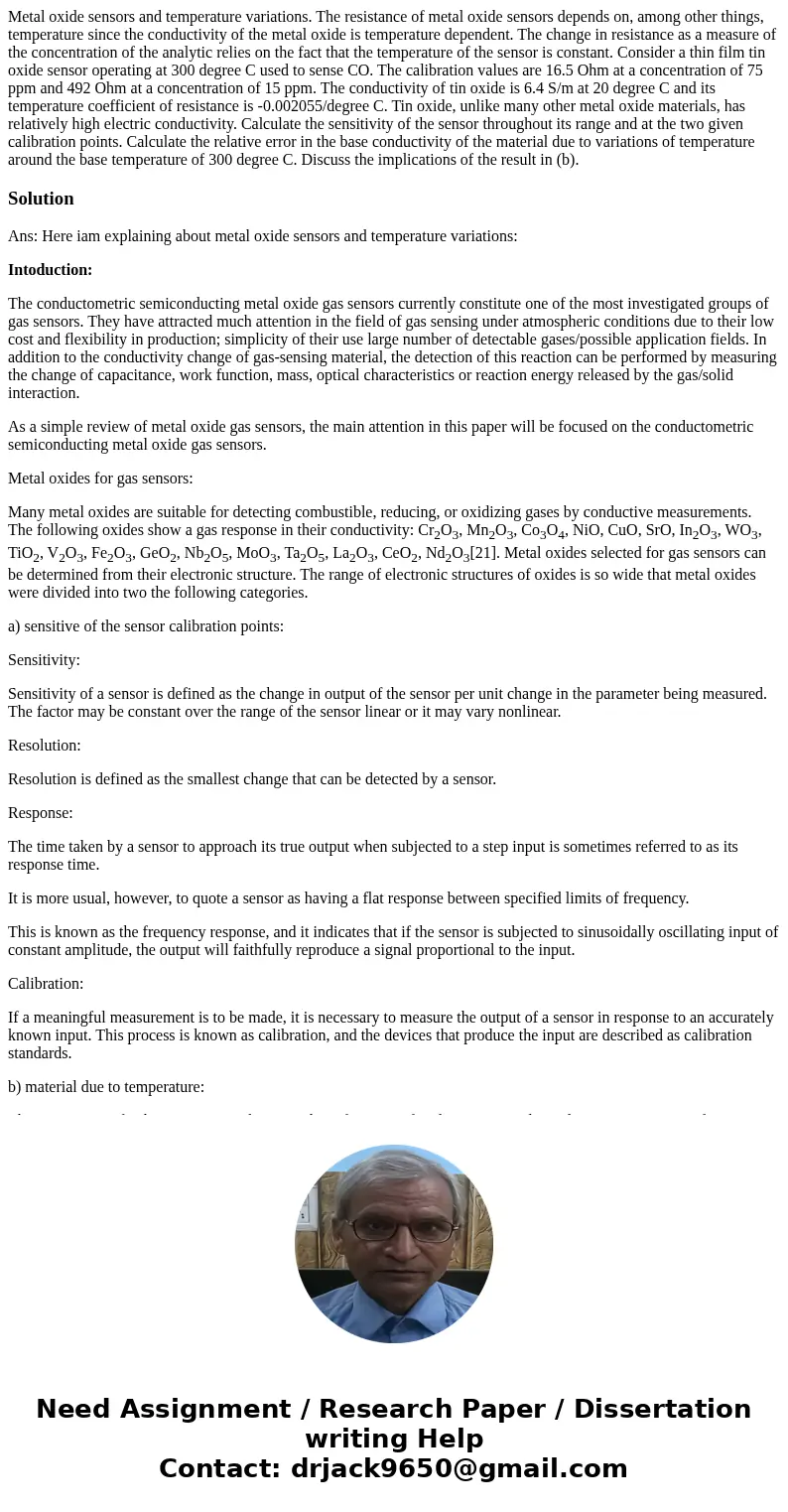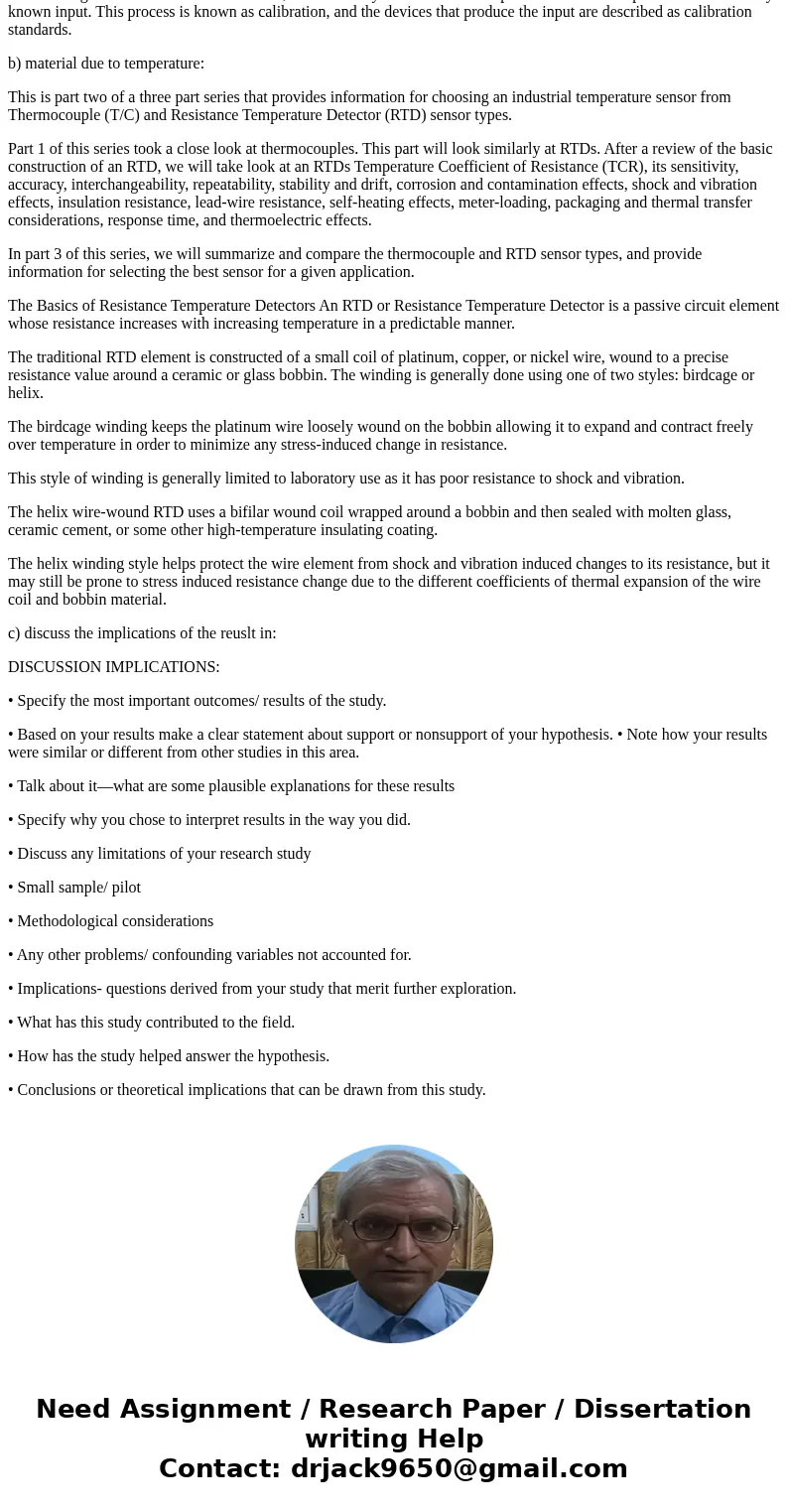Metal oxide sensors and temperature variations The resistanc
Solution
Ans: Here iam explaining about metal oxide sensors and temperature variations:
Intoduction:
The conductometric semiconducting metal oxide gas sensors currently constitute one of the most investigated groups of gas sensors. They have attracted much attention in the field of gas sensing under atmospheric conditions due to their low cost and flexibility in production; simplicity of their use large number of detectable gases/possible application fields. In addition to the conductivity change of gas-sensing material, the detection of this reaction can be performed by measuring the change of capacitance, work function, mass, optical characteristics or reaction energy released by the gas/solid interaction.
As a simple review of metal oxide gas sensors, the main attention in this paper will be focused on the conductometric semiconducting metal oxide gas sensors.
Metal oxides for gas sensors:
Many metal oxides are suitable for detecting combustible, reducing, or oxidizing gases by conductive measurements. The following oxides show a gas response in their conductivity: Cr2O3, Mn2O3, Co3O4, NiO, CuO, SrO, In2O3, WO3, TiO2, V2O3, Fe2O3, GeO2, Nb2O5, MoO3, Ta2O5, La2O3, CeO2, Nd2O3[21]. Metal oxides selected for gas sensors can be determined from their electronic structure. The range of electronic structures of oxides is so wide that metal oxides were divided into two the following categories.
a) sensitive of the sensor calibration points:
Sensitivity:
Sensitivity of a sensor is defined as the change in output of the sensor per unit change in the parameter being measured. The factor may be constant over the range of the sensor linear or it may vary nonlinear.
Resolution:
Resolution is defined as the smallest change that can be detected by a sensor.
Response:
The time taken by a sensor to approach its true output when subjected to a step input is sometimes referred to as its response time.
It is more usual, however, to quote a sensor as having a flat response between specified limits of frequency.
This is known as the frequency response, and it indicates that if the sensor is subjected to sinusoidally oscillating input of constant amplitude, the output will faithfully reproduce a signal proportional to the input.
Calibration:
If a meaningful measurement is to be made, it is necessary to measure the output of a sensor in response to an accurately known input. This process is known as calibration, and the devices that produce the input are described as calibration standards.
b) material due to temperature:
This is part two of a three part series that provides information for choosing an industrial temperature sensor from Thermocouple (T/C) and Resistance Temperature Detector (RTD) sensor types.
Part 1 of this series took a close look at thermocouples. This part will look similarly at RTDs. After a review of the basic construction of an RTD, we will take look at an RTDs Temperature Coefficient of Resistance (TCR), its sensitivity, accuracy, interchangeability, repeatability, stability and drift, corrosion and contamination effects, shock and vibration effects, insulation resistance, lead-wire resistance, self-heating effects, meter-loading, packaging and thermal transfer considerations, response time, and thermoelectric effects.
In part 3 of this series, we will summarize and compare the thermocouple and RTD sensor types, and provide information for selecting the best sensor for a given application.
The Basics of Resistance Temperature Detectors An RTD or Resistance Temperature Detector is a passive circuit element whose resistance increases with increasing temperature in a predictable manner.
The traditional RTD element is constructed of a small coil of platinum, copper, or nickel wire, wound to a precise resistance value around a ceramic or glass bobbin. The winding is generally done using one of two styles: birdcage or helix.
The birdcage winding keeps the platinum wire loosely wound on the bobbin allowing it to expand and contract freely over temperature in order to minimize any stress-induced change in resistance.
This style of winding is generally limited to laboratory use as it has poor resistance to shock and vibration.
The helix wire-wound RTD uses a bifilar wound coil wrapped around a bobbin and then sealed with molten glass, ceramic cement, or some other high-temperature insulating coating.
The helix winding style helps protect the wire element from shock and vibration induced changes to its resistance, but it may still be prone to stress induced resistance change due to the different coefficients of thermal expansion of the wire coil and bobbin material.
c) discuss the implications of the reuslt in:
DISCUSSION IMPLICATIONS:
• Specify the most important outcomes/ results of the study.
• Based on your results make a clear statement about support or nonsupport of your hypothesis. • Note how your results were similar or different from other studies in this area.
• Talk about it—what are some plausible explanations for these results
• Specify why you chose to interpret results in the way you did.
• Discuss any limitations of your research study
• Small sample/ pilot
• Methodological considerations
• Any other problems/ confounding variables not accounted for.
• Implications- questions derived from your study that merit further exploration.
• What has this study contributed to the field.
• How has the study helped answer the hypothesis.
• Conclusions or theoretical implications that can be drawn from this study.


 Homework Sourse
Homework Sourse